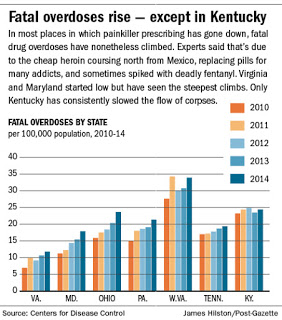Kentucky is the only truly Appalachian state to have put a brake on fatal overdoses from narcotics

Kentucky is the only truly Appalachian state to have put a brake on fatal drug overdoses, report Rich Lord and Adam Smeltz of the Pittsburgh Post-Gazette as part of a series in the about the deadly epidemic of prescription painkillers in the region.
A chart with the series’ story about Kentucky shows that fatal drug overdoses were less numerous in the state in 2013 than in 2012, when the General Assembly cracked down on “pill mills,” and that while fatal overdoses rose in 2014, they were still not as numerous as in 2012. Official numbers for 2015 are expected soon, and may rise because of the spread of heroin.
The series also credited a crackdown by the Kentucky Board of Medical Licensure, which “took disciplinary action for prescribing irregularities against 135 of
the state’s roughly 10,600 doctors” from 2011 to 2015. “The board also moved against 33
doctors during that time for abusing narcotics themselves.”
“Getting tough on doctors works,” Lord wrote in the series’ main story. The state story reported, “Kentucky’s per-capita opioid consumption — though still seventh in the
nation — dropped by a steepest-in-Appalachia 12.5 percent from 2012 to
2014, according to IMS Health Inc.,” Lord and Smeltz report. “Kentucky is the only state, among the
seven studied by the Pittsburgh Post-Gazette, in which fatal overdoses
have plateaued. Elsewhere, they have climbed relentlessly.”
The story quotes Kerry B. Harvey, U.S. attorney for the eastern half of Kentucky: “In much of Eastern Kentucky, the workforce is engaged in difficult,
manual labor,” like mining, farming and logging, “so people would
injure themselves and be prescribed these very potent narcotics, because
the medical profession changed the way it looked at prescribing these
kinds of narcotics for pain.” The drugs dulled the “sense of hopelessness” people had about the area’s
economy, “and so for whatever reason, this sort of
culture of addiction took hold.”
“Harvey said that as physicians have gone to jail, and others have
faced board discipline, the painkiller business model has adapted. . . . Now the doctors take insurance, and bill the insurer or the
government not just for the office visit, but for the MRI, urine screen
and back brace they use to justify the addictive narcotic.” Harvey said, “So instead of a cash business, in many cases now the taxpayers or
the insurance companies pay. The result is the same.
We end up with our communities flooded with these very potent
prescription narcotics.”
